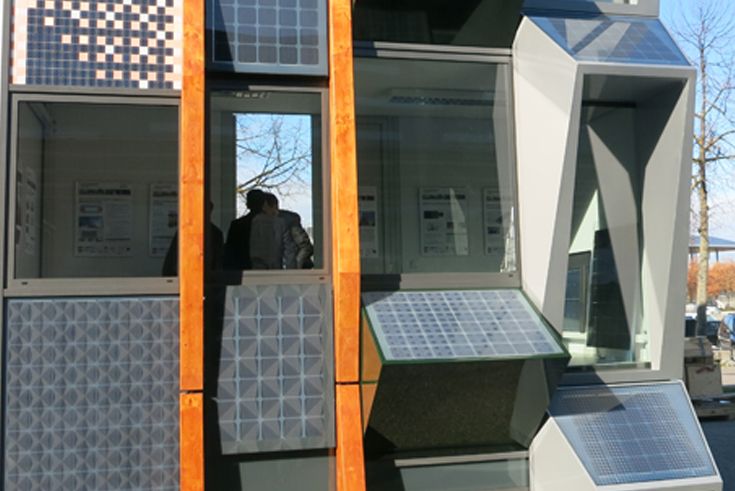Bonded photovoltaic facade

From 2020, all new buildings in EU member states are to generate as much energy as they consume, as defined within the framework of the EU's climate protection and energy-efficiency goals. Compliance with these strict EU directives calls for the use of photovoltaic systems, because they can generate renewable energy close to buildings and are low in terms of emissions, noise and maintenance. If the photovoltaic module also performs a building function such as weather protection through building integration, the amount of conventional building products used can also be reduced. Low-energy buildings generally require the additional use of the facade surface for electricity generation. The disadvantage of Building Integrated Photovoltaics (BIPV) up until now has been that the standardisation of the elements makes individual facade design difficult. In addition, the frames and mechanical fastenings of conventional modules are visually disturbing.
This was the starting point for the European joint research project Construct PV, within the framework of which efficient and cost-effective building-integrated photovoltaics for opaque surfaces in roofs and facades have been developed in an application-oriented manner and their marketability demonstrated. The consortium encompassed partners from industry and university research, in particular from the fields of PV technology and building construction, in order to connect the relevant actors. In an integrated approach, the value chain for a BIPV plant was examined, from module design and manufacturing through to system design and integration into the construction process, in order to reduce the purchase and manufacturing costs, which account for the largest share of the life cycle costs of a BIPV system.
Bonded photovoltaic test facade
The Z3 was completed in 2012 according to plans by MHM architects from Vienna. As a low-energy building, it has been awarded a German Sustainability Building Council (DGNB) Gold Certificate. Characteristic of the building are the 18-metre-high protruding and recessed pilaster strips of glued laminated timber, which contribute to the shading. They stand in contrast to the intermediate dark facade strips, in which windows and graphite-grey glass balustrades alternate. The balustrades made of ESG panes were glued according to the structural glazing principle in a load-absorbing manner. In 2017, they were replaced by glass-glass photovoltaic modules on the south facade as part of Construct PV. On Züblin's Z3 building, the PV elements now blend into the architecture thanks to a special, load-bearing adhesive without additional mechanical securing.
In order to integrate the photovoltaic modules into the building design, both structural and design solutions were required. The Dutch architecture firm UNStudio initially designed a sample facade for this purpose, which not only specified the positioning of the modules but also the design of the elements using various screen prints. For the Z3, the architects chose a design based on the serrated profile of the wood pilaster strips. In combination with the invisible, bonded fastening, the PV elements blend harmoniously into the architectural whole, and only on closer inspection can the photovoltaic modules be identified as such.
Since the projecting wooden pilaster strips partially shade the modules on the facade, each element has been divided into three electrical sections and the respective cells interconnected with other modules according to their position. In this way energy is also generated when only part of a panel is illuminated by the sun. The modules themselves were developed by the Fraunhofer Institute for Solar Energy Systems (ISE) and Meyer Burger, while the adhesive and water vapour barrier were developed by the Kömmerling research and development team.
Approval in individual cases for load-bearing bonding
The European Technical Approval 002 (ETAG 002) is the decisive set of rules for structural glazing facades, and divides facade constructions into four different types: Load-bearing bondings without any additional holding devices are regulated in the Type IV guideline. In Germany, only systems with mechanical dead-weight removal according to Type I and II are currently permitted, and therefore permanent loading of the adhesive joint is generally not permitted. Use of the glued PV modules on the five-storey Z3 building, therefore meant that individual approval had to be applied for. This was granted on the basis of the special adhesive and innovative structure of the PV elements. The front pane of the glass-glass PV modules protrudes sideways. This layered structure allows the front and rear panes to be glued independently to the substructure, so that the load transfer is split. 2-K Structural Glazing Silicone Ködiglaze S was used as the adhesive. Static and dynamic loads on the external facade, such as dead weight, wind and snow loads as well as thermal expansion, are transferred to the substructure via structural bonding.
A total of 186 photovoltaic modules in six different sizes were installed on the south facade of the Züblin office building. The area has a total output of 30 kWp and is expected to generate an electrical yield of 17,000 kWh/year. This would be enough electricity for an average detached house for around 6 months. The generated electricity is fed into the Z3 building, and the solar power yield is scientifically recorded and monitored by the ISE.
According to the researchers, the solution of bonded PV modules brings not only technical but also aesthetic advantages, which is particularly relevant for architects. The team hopes it will increase the use of building-integrated PV modules and thus environmentally-friendly energy production.


